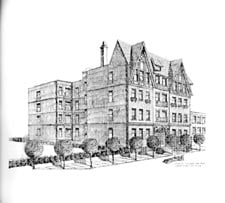 |
| The historic Georgian Court, 109-20 Queens Blvd |
 |
| The Alberta, a historic Tudor gem at 108-22 72nd Ave, which was originally 2 Roman Ave. |
Two of Forest Hills' earliest apartment houses are the Georgian Court and the Alberta, which are situated in the business and residential district in the heart of our neighborhood.
It is the compilation of low-density developments with mainly Tudor and Colonial design which surround the Austin St and Queens Blvd thoroughfares, and which grant character to what was once referred to as "Forest Hills Village" or "The Village." Let's think twice before insensitively altering or demolishing the low-rise residential and commercial sites along and in between these thoroughfares. Preserving, restoring, and adaptively reusing our assemblage of buildings which began in 1906, will pay respect to the fine craftsmanship and vision of our remarkable developers, urban planners, architects, and business owners, who would once strive to make our streestscapes harmonious and distinctive from Anytown USA. It was a complementary extension to the aura of the Forest Hills Gardens, and still is in many ways, with the exception of a few tacky aluminum or stucco-covered buildings, and the brick and steel sliver McOffices that began to rise on 72nd Ave.
We extend our gratitude to Historian Ron Marzlock of the Queens Chronicle's I Have Often Walked column, for publishing the history of the Georgian Court and The Alberta on June 23rd & June 16, 2011 respectively, and establishing the need for their preservation and that of the greater neighborhood:
Georgian Court: An Innovator in Forest Hills
 |
| Georgian Court, located at 109-20 Queens Blvd, with tennis courts to the left, May 1931. |
Georgian Court holds the distinction of being the first apartment building built on Queens Boulevard in Forest Hills. It was an innovation for its time for many other reasons too.
It was designed by Manhattan architect Louis I. Brooks of 63 Madison Ave. and was the only apartment building built in Forest Hills during the Great Depression, opening for occupancy on Oct. 1, 1930.
All apartments were built with three or four rooms and were convertible to six- or seven-room units.
The building had two Otis elevators, individual incinerators for each unit, refrigerators and gas ranges. There were no dumbwaiters. It was Forest Hills’ first apartment building with colored tile to match the fixtures in both the bathroom and kitchen, a welcome change to the stark black and white of the 1920s. References were required for tenants to rent a three-room apartment for $100 or four rooms for $140, expensive at the time.
Georgian Court’s most attractive selling point was that it was situated next to beautiful tennis courts. However, that was short lived. It was announced on Dec. 3, 1936 that a new church and rectory were to be built there for Our Lady Queen of Martyrs for $365,000. Steam shovels broke ground in May 1938, residents lost their view and they endured the noise for the next year.
Today Georgian Court sits modestly on the boulevard, obscured by all the other structures towering over it. Compared to newer buildings, residents are still very happy with its solid construction and love their 80-year-old building.
More photos of the Georgian Court, courtesy of Michael Perlman
A Forest Hills Gem: The Alberta, Built in ’23
 |
| A 1923 architect’s rendering of The Alberta, located at 2 Roman Ave, today’s 108-22 72 Ave in Forest Hills. |
The oldest apartment building in Forest Hills outside of the
Gardens I have found to be The Alberta. John S. Myers of Manhattan
was the builder, and he named the structure after his mother.
In 1922 Myers hired architect Rudolf C.P. Boehler to
design a
four-story luxury walk-up building at what was then 2 Roman Ave.
Boehler worked mainly in Manhattan, from 1920 to 1954, and this was
his only project in Queens.
Through a beautiful marble covered vestibule you enter The
Alberta’s spacious, artistically treated reception room, from where
marble stairs lead to the apartments.
One of the selling points
was Myers’ willingness to arrange the
color scheme in accordance with tenants’ wishes if leases were
signed before completion of the building. Inspection began in late
September 1923 and it was ready for occupancy on Oct. 15. Expensive
for its time, The Alberta’s A and B line of four-room apartments
cost $145 a month, the three-room C and E line was $110 and the
two-room D was $85.
Another selling point was that, as advertised,
the apartments
had a commanding view overlooking Queens Boulevard to Kew Gardens
in one direction and Jackson Heights and Elmhurst in the other.
The
building has been renumbered 108-22 72 Ave. but retains the
name Alberta. After 88 years it is in pristine condition, and
serious thought should be given to its preservation as buildings
like this will never be constructed again in Forest Hills. With the
very high value of the land alone, this beauty could be put in
danger of destruction at some point.



















